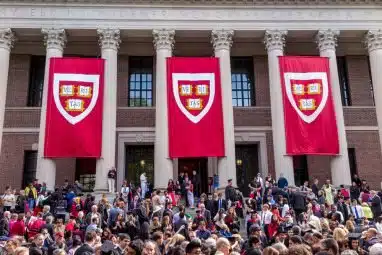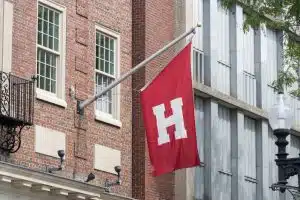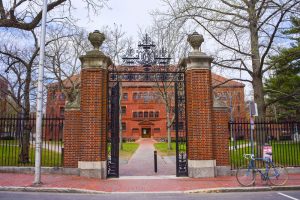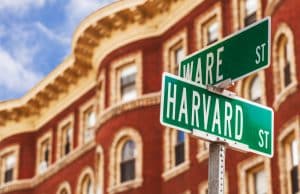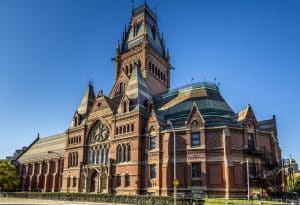Harvard University is famous for its academic brilliance, but it also has a mysterious side, thanks to its secretive “Final Clubs.” One of the most well-known of these is the Porcellian Club. Founded in 1791, it’s the oldest and often considered the most prestigious of Harvard’s eight exclusive, all-male final clubs.
In this blog, we’ll explore the fascinating history, traditions, and influence of the Porcellian Club and the controversies that this prestigious club has been involved in over the years.
- The History of the Porcellian Club
- The Porcellian Club’s Early Tradition and Practices
- The Porcellian Club’s Influence over The Years
- Porcellian Club’s Criticisms and Controversies
- Popular Porcellian Club Alumni
- What Are Harvard’s Final Clubs?
- Frequently Asked Questions
- Takeaways
The History of the Porcellian Club
The Porcellian Club got its start back in 1791 when six Harvard students decided to create something new. They shared a love for classical literature and wanted a social club that stood out from the rest on campus. That group—Robert B. Storer, Nathaniel Bowditch, Abraham Van Nest, Robert Troup, Edward Wigglesworth, and William C. Bond—came together to form what would become the Porcellian Club.
These founders were not “regular” students but from well-connected, influential families. Robert Troup’s father was a judge and a delegate at the 1787 Constitutional Convention, Nathaniel Bowditch’s family had strong ties to the shipping industry, and both Edward Wigglesworth and William C. Bond were sons of Harvard professors.
But even with their privileged upbringings, these men wanted the club to be about more than just social status. They aimed to build a community that encouraged intellectual growth and moral development. Their shared passion for classical literature and culture became the foundation for a club where like-minded individuals could connect, support one another, and pursue personal growth.
The origins of the name “Porcellian”
The name “Porcellian” comes from the Latin word “porcellus,” meaning “little pig.” It was inspired by a tavern in Florence, Italy, that had a wooden sign with a small pig hanging outside. The club’s founders saw the emblem and decided it was the perfect name for their group.
Sure, the name might sound a little quirky, but it highlights the club’s deep respect for tradition and the power of symbols in building a strong sense of identity and community. To this day, the Porcellian Club’s emblem—a boar’s head paired with its motto, Dum Vivimus Vivamus (While We Live, Let Us Live)—remains a meaningful part of its legacy.
The Porcellian Club’s Early Tradition and Practices
The Porcellian Club, often called the “Porc,” has a rich history of unique traditions that have evolved over the years. In its early days, it served as a hub for students passionate about classical studies, where members would gather to debate literature, philosophy, and politics.
As time went on, the club introduced distinctive customs that set it apart. One notable tradition is the wearing of crimson jackets adorned with brass buttons, symbolizing the club’s exclusivity and prestige. Another enduring practice is serving punch at meetings, a ritual that continues to this day.
Here are some of its popular customs:
- Exclusive membership selection. Membership is by invitation only. It follows a meticulous selection process that evaluates candidates based on lineage, social connections, and personal attributes.
- Crimson jackets with brass buttons. Members don distinctive crimson jackets adorned with brass buttons which symbolizes their affiliation and the club’s prestige.
- Pig-themed emblems. Reflecting the club’s name, members often wear accessories featuring pig imagery, such as neckties or rings, signifying their association with the Porcellian.
- Serving of punch. A longstanding tradition involves serving punch at club meetings, fostering camaraderie among members.
- Exclusive clubhouse access. The clubhouse, located at 1324 Massachusetts Avenue, is a private sanctuary for members, emphasizing the club’s exclusivity.
- Joseph McKean gate. Erected in 1901, this gate to Harvard Yard, featuring the club’s boar’s head symbol, serves as a memorial to the club’s founder and underscores its historical significance.
- Lifetime guest policy. Traditionally, the club permits an individual to visit only once in their lifetime, maintaining its aura of exclusivity.
- Preservation of artifacts. The club houses a collection of rare books, art, and memorabilia donated by members over the years, reflecting its commitment to preserving its history and traditions.
These traditions contribute to the Porcellian Club’s reputation as one of the most exclusive and prestigious social clubs globally, with a legacy deeply intertwined with Harvard University’s history.
The Porcellian Club’s Influence over the Years
The Porcellian Club has played a big role in shaping Harvard University and its surrounding academic community, and it has left a mark both historically and today.
1. On Harvard’s social scene
The Porcellian Club has been a major player in shaping Harvard’s social scene. For years, it was the heart of campus life and a symbol of the university’s exclusivity and prestige. Its members were seen as part of the social elite, with their influence often reaching far beyond the club’s walls.
The club’s exclusivity also had an impact. It promoted a sense of elitism, as its members were often from influential backgrounds, and their social connections extended beyond the university. This exclusivity sometimes led to criticism, particularly regarding the club’s lack of diversity and its exclusion of women and minorities.
Over time, the influence of the Porcellian Club has waned, especially as Harvard’s social landscape has evolved to become more inclusive and diverse. However, the club remains a symbol of Harvard’s rich history and traditions. It reflects the university’s past social structures and the evolution of its student body’s values.
2. On other secret societies
The Porcellian Club has been a blueprint for many secret societies and exclusive organizations across the country. Its unique traditions, high standards, and air of exclusivity have inspired everything from fraternities to country clubs and even corporate boardrooms.
Take Yale’s Skull and Bones, for instance. Founded in 1832, it’s one of the most well-known secret societies in the U.S., counting former presidents George H.W. Bush and George W. Bush among its members. It’s widely believed that Skull and Bones was modeled after the Porcellian Club, adopting similar practices of secrecy and exclusivity.
Dartmouth’s Sphinx Club, founded in 1885, is another example. Inspired by the Porcellian Club, it built its reputation on exclusivity, mystery, and a select membership process.
The Porcellian Club’s influence has stretched far beyond Harvard’s campus, setting the standard for elite organizations. Its traditions and structure have created a legacy that continues to shape how other groups define themselves, emphasizing tight-knit communities, exclusivity, and a shared sense of tradition.
3. On popular culture
The Porcellian Club isn’t just a Harvard institution—it’s also made a splash in popular culture. Its reputation for exclusivity and mystery has been portrayed in countless books, movies, and TV shows. It’s shaped how people view elite social clubs.
You might remember the club being referenced in The Social Network, where it’s depicted as one of those almost mythical organizations that symbolize power and status. In Gilmore Girls, it takes on a similarly glamorous and elite vibe, playing into its real-world reputation as a private, prestigious group.
Even classic literature has its nods to the Porcellian Club. In J.D. Salinger’s The Catcher in the Rye, Holden Caulfield mentions it as a symbol of the upper-class society he deeply resents; it shows its association with privilege and exclusivity.
More recently, in the TV show Gossip Girl, the club is portrayed as a secretive, high-society group that only admits the wealthiest and most influential students, reinforcing its image as a gatekeeper of elite social circles.
Over the years, the Porcellian Club has become a shorthand for the exclusive and powerful, making it a perfect fit for stories about ambition, privilege, and social hierarchy. Whether glamorized or criticized, its presence in pop culture only adds to the aura of mystery surrounding it.
Porcellian Club’s Criticisms and Controversies
The Porcellian Club, one of Harvard’s oldest and most exclusive final clubs, has had its fair share of controversies and criticism over the years. Here are some of them:
1. Exclusivity and elitism
The Porcellian Club, founded in 1791, symbolizes prestige at Harvard but faces criticism for fostering elitism. Membership is by invitation, often favoring affluent, influential students, which critics say reinforces class divides and exclusivity.
While supporters view it as a tradition-preserving community, the club remains a focal point in debates on privilege and inclusivity at Harvard. Despite criticism, it continues to uphold its practices, reflecting the university’s historical elite structures.
2. Gender discrimination
The Porcellian Club’s all-male membership policy has faced significant criticism, especially as societal views on gender equality have shifted. In the 1980s, Harvard urged final clubs to admit women, but the Porcellian chose to sever ties with the university instead, preserving its male-only tradition.
Critics see this as reinforcing exclusion and denying women access to valuable networks. While the club defends its stance as preserving tradition, it has sparked broader debates about the balance between historical customs and modern inclusivity.
3. Racial discrimination
The Porcellian Club’s history has not been without controversy regarding racial discrimination. In 1979, an incident brought the issue to the forefront when a club member reportedly vetoed the admission of a Black student. This decision caused significant internal tension, leading to disagreements among members and even prompting some to resign in protest.
The episode showed the club’s racial exclusivity and raised questions about its commitment to inclusivity at a time when societal attitudes toward diversity were beginning to shift more visibly.
Although the club admitted its first Black member in 1983, the event served as a stark reminder of the slow progress toward racial equality within such elite organizations. Critics argue that this important milestone was long overdue and reflective of a broader pattern of exclusion rooted in the club’s history.
The incident also sparked broader conversations about the role of final clubs in perpetuating racial inequalities and the need for these institutions to reflect the diversity of the communities they serve. Despite some steps forward, the Porcellian Club continues to face scrutiny regarding its representation and how it navigates issues of race and inclusivity today.
4. Sexual assault and safety concerns
In recent years, the club has been scrutinized for its association with a culture that may contribute to sexual misconduct. A 2016 Harvard University report linked all-male final clubs to higher rates of sexual assault on campus.
In response, the Porcellian Club argued that its policies, such as prohibiting guests in its clubhouse, mitigate such risks. However, critics contend that the club’s stance reflects a reluctance to address deeper cultural issues related to gender and power dynamics.
5. Resistance to institutional change
The Porcellian Club’s refusal to adopt co-educational policies has created tensions with Harvard University. In 2016, the university introduced sanctions against single-gender organizations, barring students in these groups from certain leadership roles and fellowship opportunities to promote inclusivity.
The Porcellian Club opposed these measures, arguing they interfered with private traditions and could harm campus unity. Despite criticism and pressure, the club has maintained its single-gender policy, emphasizing tradition over institutional changes.
Popular Porcellian Club Alumni
The Porcellian Club, one of Harvard’s oldest and most exclusive final clubs, has been associated with numerous notable figures who have made significant contributions across various fields. Here are some distinguished members and their roles in society:
- Theodore Roosevelt. As the 26th President of the United States, Roosevelt was a driving force behind the Progressive Era, implementing reforms that addressed issues like corporate monopolies and labor conditions.
- Oliver Wendell Holmes Jr.. Serving as an Associate Justice of the U.S. Supreme Court from 1902 to 1932, Holmes was renowned for his clear legal opinions and contributions to the development of American common law.
- Henry Cabot Lodge. A U.S. Senator from Massachusetts, Lodge was a key figure in American foreign policy, notably opposing the Treaty of Versailles and the League of Nations.
- Paul Nitze. A significant figure in U.S. defense policy during the Cold War, Nitze held positions such as Secretary of the Navy and Deputy Secretary of Defense.
- Leverett Saltonstall. Serving as both Governor of Massachusetts and a U.S. Senator, Saltonstall played a pivotal role in state and national politics.
- Richard Henry Dana Jr. An author and lawyer, Dana is best known for his memoir “Two Years Before the Mast,” which provided a vivid account of maritime life and advocated for sailors’ rights.
- H. H. Richardson. A prominent architect, Richardson’s designs, including Boston’s Trinity Church, have had a lasting impact on American architecture.
- Cameron and Tyler Winklevoss. Known for their involvement in the early development of Facebook and later as entrepreneurs in the cryptocurrency industry, the Winklevoss twins have been influential in the digital finance space.
What Are Harvard’s Final Clubs?
Final clubs are private, exclusive social groups at Harvard University, famous for their secrecy, prestige, and deep-rooted traditions. These clubs, which include both all-male and co-ed options, are separate from the university and operate independently. Joining one is no easy feat—membership is invitation-only, with a strict selection process that often prioritizes social connections and family background.
Over the years, final clubs have been seen as places for building elite networks and fostering close friendships, but they’ve also drawn criticism for being exclusive, lacking diversity, and resisting efforts to make them more inclusive.
Here’s a breakdown of these clubs:
All-male final clubs
- Porcellian Club (Founded in 1791)
- A.D. Club (1836)
- Fly Club (1836)
- Delphic Club (1846)
- Phoenix S.K. Club (1895)
- Owl Club (1896)
- Fox Club (1898)
All-female final clubs
- Bee Club (Founded in 1991)
- The Seneca (1999)
- The IC Club (2000)
- The Pleiades Society (2002)
- La Vie Club (2008)
- The Exister Society (2017)
Co-ed final clubs
- Spee Club (Founded in 1852)
- Sab Club (2002)
These clubs are independent of Harvard University and have been part of its social fabric for centuries, each contributing uniquely to the campus’s cultural and social life.
Frequently Asked Questions
1. Does the Porcellian Club still exist?
Yes, the Porcellian Club still exists, maintaining its traditions as one of Harvard’s most exclusive and secretive final clubs.
2. Does being a member of the Porcellian Club enhance the appeal of your resume?
Being a member of the Porcellian Club can enhance the appeal of your resume in certain circles, particularly where exclusivity, tradition, and connections to influential networks are valued. The club’s prestige and historical significance at Harvard may signal leadership, elite social ties, and access to powerful networks, which could be appealing in industries like finance, law, or politics.
However, its impact depends heavily on the context and the perspective of those evaluating your credentials. The club’s exclusivity and controversial history might not carry the same positive weight in modern or progressive settings.
3. What is the most exclusive club at Harvard?
The Porcellian Club is often considered the most exclusive and prestigious club at Harvard. Founded in 1791, it is one of the university’s oldest final clubs and is renowned for its strict membership process, which is by invitation only.
Takeaways
Exploring the Porcellian Club gives you an intriguing peek into Harvard’s secretive and elite social world. The Porcellian Club was founded in 1791 by six Harvard students passionate about classical literature. Despite their privileged backgrounds, they aimed to create a space focused on intellectual growth, moral development, and camaraderie.
- The club’s name, inspired by a tavern in Florence, Italy, reflects its respect for tradition and symbolism.
- The Porcellian Club has significantly shaped not only Harvard’s social scene but also inspired the creation of other exclusive organizations, such as Yale’s Skull and Bones and Dartmouth’s Sphinx Club.
- Over the years, the club has faced scrutiny for its exclusivity, gender discrimination, and racial issues. Its all-male membership policy and selective invitation process have been criticized for fostering elitism and inequality.
- Dreaming of getting into Harvard? A strong GPA is just the start. Work with a college admissions expert to increase your chances of getting into one of the world’s most competitive schools.

